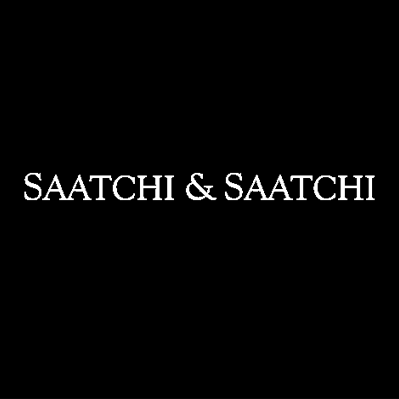Description
Saatchi & Saatchi is a British multinational communications and advertising agency network with 114 offices in 76 countries and over 6,500 staff. It was founded in 1970 and is currently headquartered in London. The parent company of the agency group was known as Saatchi & Saatchi PLC from 1976 to 1994, was listed on the New York Stock Exchange until 2000 and, for a time, was a constituent of the FTSE 100 Index. In 2000, the group was acquired by the Publicis Groupe. In 2005 it went private.
History
Early years (1970–1975)
Saatchi & Saatchi was founded in London by brothers Maurice (now Lord Saatchi) and Charles in 1970. Following stints starting as a copywriter at the New York City offices of Benton & Bowles in 1965, then at Collett Dickenson Pearce and John Collins & Partners, Charles Saatchi teamed up with art director Ross Cramer, and the genesis of what would become Saatchi & Saatchi was born in London in 1967 as the creative consultancy CramerSaatchi. The consultancy took on employees John Hegarty and Jeremy Sinclair and began to work direct for clients. It was Sinclair's "Pregnant Man" ad for the Health Education Council which first attracted attention to the small agency. Charles's younger brother Maurice joined the business in 1970 after Cramer's departure whereupon it was renamed "Saatchi and Saatchi" and developed into a full-service advertising agency.
As a creative consultancy they had mainly worked on projects primarily for agencies but having become a full service agency they were able to quickly build their own solid client base and, by 1975, this included blue-chip clients such as Associated Newspapers, British Leyland, Brutus Jeans, Cunard, Dunlop, National Magazines, and Nestle. They also worked for the Labour Party.
It was during these early years that the agency produced its first famous ad: the Pregnant Man for the UK's Health Education Council featuring a man who appeared to be pregnant.
In 1975, the Saatchi brothers set upon a ferocious course of business acquisitions. With the reverse takeover of the Garland Compton agency in 1975, they achieved a public company listing and were thereafter able to make rights issues to raise the capital required for their acquisition drive.
Garland Compton were a long established, conservative British agency, founded by Sidney Garland in 1927. In 1960, the US agency, Compton Advertising, bought a minority holding so that they could build their own international network, primarily to service their largest client, Procter & Gamble. Garland Compton was also a top 10 agency with big spending clients including Bass, British Caledonian, Gillette, New Zealand Dairy Board, Procter & Gamble, Schweppes and United Biscuits. They had also established a regional network of agencies and, of course, had access to the global Compton network. With the merger, the key management positions were taken by Saatchi people.
With the merger, Saatchi & Saatchi moved into Garland Compton's offices on 80 Charlotte Street in the west end of London; and the agency now found itself in the UK Top 5 agencies for size of billings.
Acquisition by Publicis Groupe (2000)
In 2000, after speculation that it would be acquired by WPP or Omnicom, Saatchi & Saatchi joined the Publicis Groupe, a global marketing concern based in Paris, France. Publicis kept Roberts as CEO, content with his vision for an "ideas agency". Saatchi & Saatchi still underwent some turmoil throughout this time, as the dot-com bubble saw the closure of its San Francisco office, which effectively ended its 15-year relationship with the Hewlett-Packard company. The account was subsequently split between a Publicis agency and creative agency Goodby, Silverstein and Partners. Johnson & Johnson also decided to review its relationship, withdrawing its $US100m Tylenol account from the New York office. A few months later, InBev announced that its Beck's Beer account would shift to Leo Burnett after only a year at the agency. As a result, Roberts committed to building revenue through its existing clients, which led to additional assignments, with Saatchi Los Angeles securing new accounts such as Pur Filtered Water and Millstone Gourmet Coffee. Efforts were also made to shore up the Los Angeles office after it missed a $US40 million brief for Toyota's Scion, a new sub-brand targeted at youth, which was given to San Francisco-based Attik, a hybrid creative agency.
Despite these losses, this strategy gave rise to the Lovemarks philosophy – a theory espoused in a book by the same name released by Roberts. While this met with scepticism in the advertising world, Roberts was vindicated in 2006 when he secured nearly $US700 million worth of billings from two clients, Wendy's and department store JC Penney. Subsequent additions to the New York office, such as the New York Tourism Board and Cold Stone Creamery have been described by both client and agency as 'being due to a strong belief in the Lovemarks' philosophy. Despite this, after only a year with the agency, Wendy's decided to pull the majority of its business into another roster agency, Kirshenbaum Bond & Partners, after complaints from Wendy Thomas (the namesake of the restaurant) who did not take kindly to her likeness being used in the advertising.
In 2005, critics complained that in creating a £20 million campaign for a new Brazilian spirit the agency spray-painted graffiti images on walls and buildings in the East End of London.
Dr Martens CEO David Suddens decided to fire Saatchi & Saatchi as their advertiser on 24 May 2007. This was because of a one-time advertisement that used a picture of 1990s music icon Kurt Cobain without the permission of Courtney Love, Cobain's widow. In its defence, Saatchi released a statement indicating their regret of Dr Marten's decision to terminate their services with them but emphasising that they believed that the advertisement was deliberately edgy but not offensive.
Although the agency had gained early fame for its "Labour isn't working" advertising for the Conservative Party in 1979, in 2007 it was appointed the advertising agency for the Labour Party. The agency then devised the Not Flash, Just Gordon advertising campaign for the party in anticipation of the calling a snap general election by the newly installed Prime Minister, Gordon Brown.
Saatchi & Saatchi Fallon Group (2007–2017)
Over time, the agency had lost some of its pre-eminent position in the UK and elsewhere. In 2016, for example, the UK agency was sitting at Number 12 in Campaign Magazine table of agency billings.
In 2017, the global CEO Kevin Roberts left the agency after a controversy around comments that he made regarding women's equality in the advertising industry. He was replaced by Robert Senior.
By the end of 2017, the alliance broke up as Fallon was "realigned" into another Publicis Groupe communications agency, Leo Burnett.
Saatchi & Saatchi Rebuilds (2017 – present)
Under the supervision of new CEO Magnus Djaba, Saatchi & Saatchi London moved out of 80 Charlotte Street, its HQ for over fifty years. They set up a new purpose-built Publicis Communications campus and Saatchi & Saatchi global headquarters at 40 Chancery Lane, London.
Following in the tradition of the staff-only pub; the company created a new onsite joint venture, again named 'The Pregnant Man' which is open to the public.





















